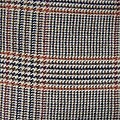
Tweed is a rough, woollen fabric, of a soft, open, flexible texture, resembling cheviot or homespun, but more closely woven. It is usually woven with a plain weave, twill or herringbone structure. Colour effects in the yarn may be obtained by mixing dyed wool before it is spun. [1]
Contents
- Etymology
- Traditions and culture
- Musical instruments
- Types of tweed
- Gallery
- See also
- Notes
- References
- External links
Tweeds are a staple of traditional Scottish, Irish, Welsh, and English clothing, being desirable for informal outerwear, [2] due to the material being moisture-resistant and durable. Tweeds are made to withstand harsh climates [3] and are commonly worn for outdoor activities such as shooting and hunting. In Ireland, tweed manufacturing is now most associated with County Donegal but originally covered the whole country. [4] In Scotland, tweed manufacturing is most associated with the Isle of Harris in the Hebrides.














